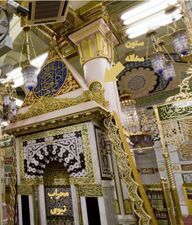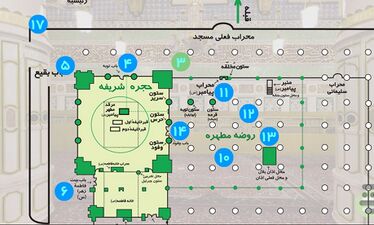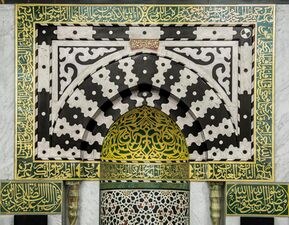The Prophet's Mihrab
 | |
| General Information | |
|---|---|
| Other Names | Mihrab al-Nabi, Mihrab Rasulallah |
| Place | Masjid al-Nabi |
| History | |
| Reconstructions | In the time of Umar b. Abdul Aziz and Mamalik of Egypt |
| Reconstructors | Qāytbāy |
Prophet's Miḥrāb(Arabic:محراب النبي) is the place where the Prophet Muḥammad(a) prays, which is located in the Masjid al-Nabī between the Prophet's pulpit and his grave. During the period of the Prophet, there was nothing in the form of a miḥrāb, until during the development of the Masjid al-Nabī during the period of Walīd b. Abdul-Malik, a miḥrāb was built in the place of his prayer. Qāytbāy, the king of Egypt (9th/15th century) rebuilt the hollow-shaped miḥrāb by renewing the mosque. this miḥrāb was decorated during the era of Ottoman rule and is still located in Masjid al-Nabī.
History
During the time of the Prophet Muḥammad(a), in the place of Masjid al-Nabī where he prayed, there was no miḥrāb in the form of a hollow-shaped inside the wall. [1] and the place of prayer of the Prophet, had no sign except that it was next to the Mukhallaqa pillar.[2] This was the first time in the development of Masjid al-Nabī. During the period of Walīd b. Abdul-Malik (r. 86-96 AH/705-714-5), a miḥrāb was built at the place of the Prophet's prayer.[3]
During the Mamālīk period
Although historical sources do not have any reports about the reconstruction of the miḥrāb during the period of Baybars Bunduqdārī (r. 658-676 AH/1259-60 -1277-8 AD), the fourth Mamālīk king, some researchers, by examining historical evidence, believe that the first hollow-shaped miḥrāb (carved into the wall) in the reconstructions of the Baybars period was made in the place that Prophet Muḥammad(a) prayed; Because the reports of the sources before this date did not mention the existence of a hollow-shaped miḥrāb in the place of Prophet's prayer.[4] In the reconstruction of Masjid al-Nabī during the period of Qāytbāy, the king of Egypt, in 888 AH/1483-4 AD after the fire in Masjid al-Nabī, the miḥrāb was rebuilt in the place of the Prophet's prayer, and in the same period, it was decorated with marble and verses from the Quran were engraved on it[5]
In the Ottoman period
In the reconstruction of Masjid al-Nabī during the reign of king Abdul-Majīd I, the Prophet's miḥrāb, which was left over from the time of Qāytbāy, was gilded. Also, during this time, ʿAbd Allāh Zāhidī, a Turkish calligrapher, engraved verses of the Quran, texts and poems on the miḥrāb.[6] In the Saudi period, the same miḥrāb of the Qāytbāy period remained.[7]
location
The Prophet's miḥrāb was built in the place of Masjid al-Nabī where Prophet Muḥammad(a) prayed.[8] This miḥrāb is located next to the Mukhallaqa pillar[9] and in the distance between the pulpit of the Prophet(a) and his grave (Rawḍa al-Sharīfa).[10] Researchers are of the opinion that this place is the place where the Prophet(a) prayed. [11] The miḥrāb is placed in such a way that the one who prostrates on it places his forehead on the Prophet's sitting place, not his prostration place. [12] The Prophet's prostration place is placed under the miḥrāb.[13]
Gallery
-
The altar of the Prophet is connected to the Mukhallaqa pillar.
-
The location of the Prophet's miḥrāb in the map Masjid al-Nabī.
-
Decorations of the prophet's miḥrāb with marble and gilding and verses from the Quran are written on it.
Notes
- ↑ Ṣāliḥī Lumaʿī, Al-madīna al-munawwara, P. 59.
- ↑ ʿAṭṭār, Al-Taʿrīf bi tārīkh wa maʿālim al-masjid al-nabawīī al-sharīf, p. 162.
- ↑ Sayyid al-Wakīl, Al-masjid al-nabawīī ʿabar tārīkh, p. 128; Jaʿfariyān, Āthār-i islāmi-yi Makka wa Madīna, p. 260.
- ↑ al-Shahrī, ʿImāra al-masjid al-nabawīī, p. 227.
- ↑ al-Shahrī, ʿImāra al-masjid al-nabawīī, P. 342.
- ↑ Ṣāliḥī Lumaʿī, Al-madīna al-munawwara, p. 96.
- ↑ Ansārī, ʿImārah wa tawsiah al-masjid al-nabawīī, p. 170.
- ↑ Sayyid al-Wakīl, Al-masjid al-nabawīī ʿabar tārīkh, p. 128; Jaʿfariyān, Āthār-i islāmi-yi Makka wa Madīna, p. 260.
- ↑ Sayyid al-Wakīl, Al-masjid al-nabawīī ʿabar tārīkh,p. 163.
- ↑ Sayyid al-Wakīl, Al-masjid al-nabawīī ʿabar tārīkh,p. 163.
- ↑ Sayyid al-Wakīl, Al-masjid al-nabawīī ʿabar tārīkh, p. 128; Jaʿfariyān, Āthār-i islāmi-yi Makka wa Madīna, p. 260.
- ↑ Sayyid al-Wakīl, Al-masjid al-nabawīī ʿabar tārīkh,p. 163.
- ↑ ʿAṭṭār, Al-Taʿrīf bi tārīkh wa maʿālim al-masjid al-nabawīī al-sharīf, p. 164.
References
- Ansārī, Nājī Muḥammad Ḥasan ʿabdu l-qādir al-. ʿImārah wa tawsiah al-masjid al-nabawīī al-sharīf ʿabar tārīkh. [n.p], Nādī l-madīna al-munawwara al-adabī, 1996.
- Hazzaʿ al-Shahrī, Muḥammad .ʿImārah al-masjid al-nabawīī munzu inshāʾihī ḥattā nihāya al-ʿasr al-mamlūkī. Cairo: Cairo: Maktabat al-qāhira li-l kutub, 2001.
- Hazzaʿ al-Shahrī, Muḥammad .Al-masjid al-nabawīī al-sharīf fī al-ʿasr al-ʿuthmānī. . Cairo: Dār al- qāhira, 2003.
- Jaʿfariyān, Rasūl. ‘’Āthār-i islāmi-yi Makka wa Madīna’’. Tehran: Mashʿar, 1391 Sh
- Ṣāliḥī Lumaʿī, Muṣṭafā .Al-madīna al-munawwara taṭawwurihā al-ʿumrānī wa turāthiha al-miʿmārī. Beirut: Dār al-Nihḍa al-‘Arabīyya, 1981.
- Sayyid al-Wakīl, Muḥammad al- .Al-masjid al-nabawīī ʿabar tārīkh. [n.p], Dār al-mujtamaʿ li-lnashr wa al-tawziʿ, 1988.
- Sayyid Ḍīyāʾ b. Muḥammad b. Maqbūl ʿAṭṭār.Al-Taʿrīf bi tārīkh wa maʿālim al-masjid al-nabawīī al-sharīf. Jeddah: Kunūz al-maʿrifa, 1432 AH.


